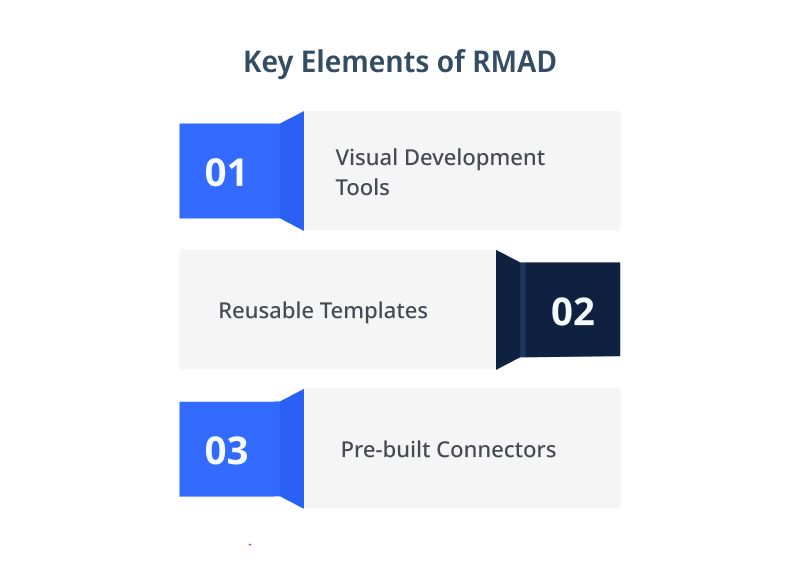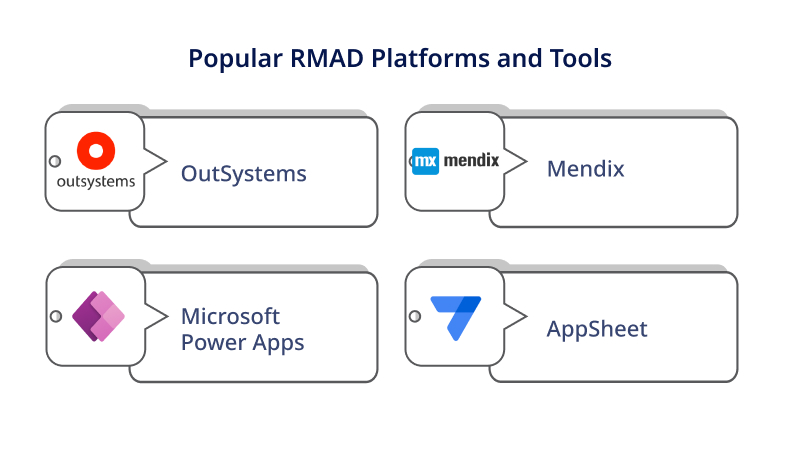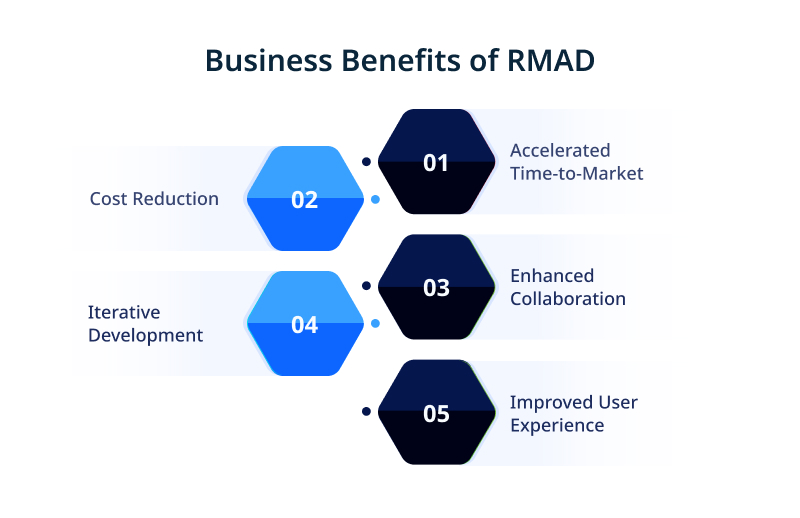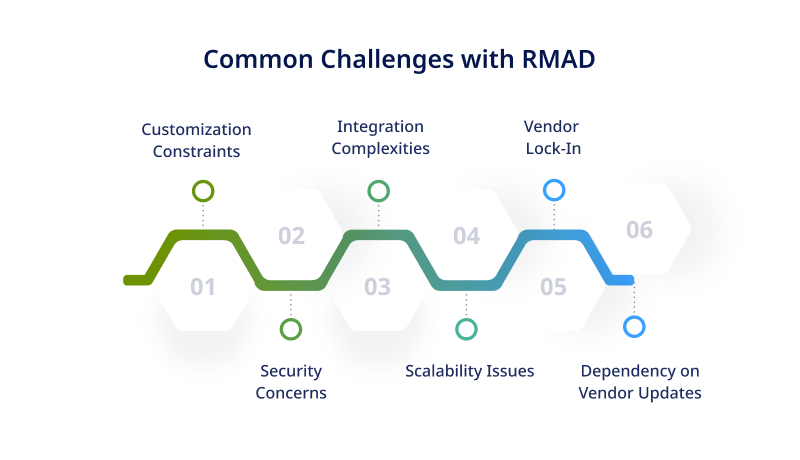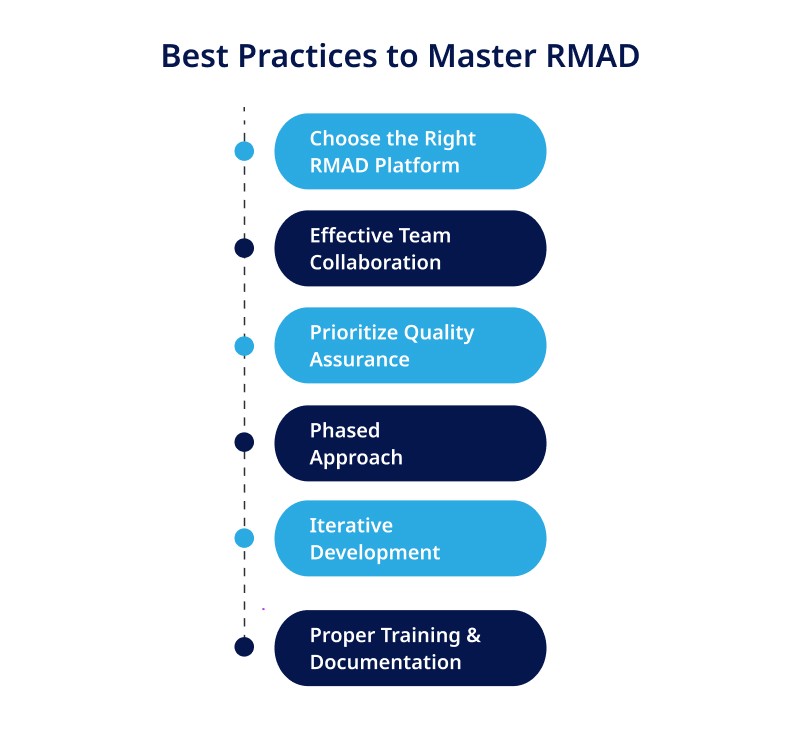In a world that never stops moving, staying ahead in the digital race becomes essential. To keep your business thriving, you need a secret weapon: Rapid Mobile App Development (RMAD).
With its nimble approach, RMAD empowers businesses to keep pace and leap ahead. This blog delves deep into RMAD’s inner workings, unveiling its prowess in revolutionizing the mobile app development sphere.
Table of Contents
RMAD – A Quick Overview
The demand for mobile apps is ever-growing, with an estimated 128 billion downloads in 2020 alone, and is expected to generate $935 billion in revenue by the end of 2023.
As the world turns to mobile solutions for convenience, businesses are racing to deliver apps that meet consumer needs. It is where RMAD, or Rapid Mobile App Development, takes center stage.
A transformative approach to app development, RMAD is a method that recognizes the pressing need for businesses to bring their apps to market swiftly without compromising quality. RMAD platforms equip developers with tools that streamline the development process.
These tools include visual interfaces, pre-built templates, and ready-to-use components, reducing the reliance on extensive coding.
The result? – An agile development process that slashes the time it takes to conceptualize, build, and deploy mobile apps.
RMAD empowers businesses to stay ahead in the mobile app race, ensuring they can swiftly respond to changing market demands and consumer expectations. In essence, the method isn’t just about developing apps; it’s about building the future of mobile innovation with speed and precision.
Building Blocks of RMAD: Crafting Apps with Ease
Rapid Mobile App Development (RMAD) simplifies the complex, streamlining the creation of mobile apps by incorporating several indispensable building blocks:
Visual Development Tools
At the core of RMAD are intuitive, drag-and-drop visual development tools. These tools allow developers and non-developers to design and configure app interfaces, screens, and features without extensive coding.
It’s like visually painting your app’s canvas, making it accessible to a broader audience.
Reusable Templates
RMAD platforms offer libraries of pre-designed templates. These templates encompass common app elements such as login screens, navigation menus, and forms.
By leveraging these templates, developers save substantial time and effort crafting the app’s UI components. These templates serve as starting points, which can be customized to align with specific branding or functionality needs.
Pre-built Connectors
One of RMAD’s standout features is its pre-built connectors or integrations. These connectors bridge your app and external data sources, services, or APIs.
RMAD platforms typically provide a vast array of connectors to popular services like databases, cloud storage, and third-party APIs.
These connectors facilitate data exchange and interaction with external systems, enabling your app to tap into a world of functionalities seamlessly.
The Synergy of Building Blocks
The magic of RMAD happens when these building blocks collaborate:
Visual Tools + Templates: Visual development tools allow you to incorporate pre-designed templates into your app effortlessly. This merging of visual design and pre-built UI elements accelerates the creation of stunning app interfaces.
Templates + Pre-built Connectors: Templates often come pre-configured with connectors, meaning they are ready to fetch and display data from various sources. It enhances the app’s functionality without the need for extensive coding.
Visual Tools + Connectors: Visual development tools can simplify the configuration of connectors. For instance, they make it easy to map how data is fetched and displayed, all done visually without delving deep into code.
Examples of Popular RMAD Platforms and Tools
- OutSystems: Known for its user-friendly visual development environment, OutSystems empowers organizations to build enterprise-grade apps quickly.
- Mendix: Mendix offers a low-code development platform, incorporating visual development tools and pre-built connectors, making it ideal for RMAD.
- Microsoft Power Apps: Part of the Microsoft Power Platform, Power Apps provides visual tools and extensive connectors for building customized apps.
- AppSheet: AppSheet focuses on no-code development, allowing business users to build apps using spreadsheets as the data source.
Moreover, you can hire app developers in India and empower your business with top-notch mobile applications catering to your needs.
Discover the power of Rapid Mobile App Development (RMAD) in this detailed overview. Accelerate your app journey with insights and strategies for success.
Unlocking Success with RMAD: Benefits Beyond Imagination
Adopting Rapid Mobile App Development (RMAD) as businesses navigate the digital landscape stands out as a game-changer.
RMAD promises many benefits that extend far beyond initial expectations, ushering in a new era of agile app development:
Accelerated Time-to-Market
Time is of the essence in today’s dynamic business environment. RMAD’s streamlined development process empowers organizations to bring their apps to market with unprecedented speed.
No longer constrained by lengthy development cycles, businesses can seize opportunities as they arise, gaining a competitive edge.
Cost Reduction
Traditional app development often involves extensive coding and large teams, leading to significant expenses. RMAD offers a cost-effective alternative by reducing the need for extensive coding and allowing smaller teams to create robust rapid development applications. This shift translates into substantial cost savings without compromising quality.
Enhanced Collaboration
RMAD democratizes app development, inviting business users and domain experts. This collaborative approach fosters a strong partnership between IT and business teams, improving app functionality with business goals.
Empowered business users can actively contribute to app creation, ensuring the final product resonates with their vision.
Iterative Development
RMAD’s agility encourages iterative development. Organizations can swiftly release Minimum Viable Products (MVPs), gather user feedback, and iterate based on real-world usage.
This iterative approach ensures the app evolves to meet changing market needs and user expectations.
Improved User Experience
RMAD enables organizations to focus on delivering exceptional user experiences. Businesses can cultivate user satisfaction, engagement, and loyalty by rapidly responding to user feedback and evolving the app accordingly.
RMAD vs. Traditional App Development
The choice between the two approaches depends on project requirements and priorities. Let’s see how both the approaches differentiate from each other:
|
Parameters |
Rapid Mobile App Development (RMAD) |
Traditional App Development |
|
Development Speed |
Swift and efficient |
Time-consuming |
|
Costs |
Cost-effective |
Expensive |
|
Flexibility |
Limited customization |
Highly customizable |
|
Complexity |
Simplified |
Complex |
|
Development Resources |
Fewer developers required |
An extensive development team needed |
Also Read: Hybrid App Development: Exploring Benefits & Overcoming Limitations
Navigating RMAD Challenges: Pitfalls to Watch Out For
RMAD brings a world of convenience to the app development landscape, but like any technology, it’s not without its challenges. Understanding and proactively addressing these pitfalls is crucial to ensuring a successful RMAD journey:
Customization Constraints
While RMAD’s pre-built components and templates speed up development, they can sometimes limit extensive customization. Here’s how to navigate this challenge:
- Assessment: Evaluate your app’s unique requirements. If extensive customization is non-negotiable, weigh it against the time-to-market benefits of RMAD.
- Hybrid Approach: Consider combining RMAD with traditional development for complex, highly customized features.
Security Concerns
Simplified development can inadvertently lead to security vulnerabilities. Guarding against these risks is paramount:
- Security Awareness: Train your development team in secure coding practices specific to RMAD.
- Regular Testing: Conduct security audits and penetration testing to identify and address vulnerabilities.
Integration Complexities
RMAD apps may struggle when integrating with legacy systems or complex APIs. Here’s how to tackle integration challenges:
- API Evaluation: Prioritize RMAD platforms with strong API integration capabilities.
- Middleware Solutions: Implement middleware or integration tools to bridge the gap between RMAD apps and existing systems.
Scalability Issues
RMAD solutions face scalability constraints when handling a growing user base or increased data. To ensure scalability:
- Scalability Testing: Conduct thorough load testing during development to identify potential bottlenecks.
- Regular Updates: Stay informed about platform updates and optimizations to support scalability.
Vendor Lock-In
Choosing an RMAD platform can sometimes lead to vendor lock-in, making switching to other development approaches or providers challenging. Here’s how to minimize this risk:
- Open Standards: Prefer RMAD solutions that adhere to open standards and allow easy data export and transition.
- Exit Strategy: If the switch arises, develop a clear exit strategy, including data migration plans.
Dependency on Vendor Updates
RMAD platforms may require updates and maintenance by the vendor. Over-reliance on these updates can affect your app’s stability:
- Maintenance Plan: Develop an in-house maintenance plan to promptly handle critical updates and bug fixes.
- Vendor Communication: Establish clear communication channels with your RMAD vendor for updates and support.
Dive deep into Rapid Mobile App Development (RMAD) for unparalleled insights. Unleash innovation with our comprehensive guide. Elevate your app game now!
RMAD Across Industries: A Revolution in Diverse Sectors
RMAD is transforming the landscape of various industries, revolutionizing how businesses interact with their customers and streamline operations.
Here, we delve into some key sectors where RMAD has left a substantial imprint, showcasing specific use cases:
Healthcare
RMAD has created a new patient care and management era in the healthcare sector. Apps developed using RMAD enable healthcare providers to enhance patient experiences and optimize their internal processes.
For instance, appointment scheduling apps, electronic health record (EHR) access, and telemedicine platforms have flourished, making healthcare services more accessible and efficient.
Retail
Retailers embrace RMAD to improve customer engagement and shopping experiences. With features like barcode scanning, mobile payments, and personalized promotions, retail apps developed with RMAD empower customers to shop smarter and more conveniently.
Finance
The finance industry has witnessed a surge in mobile banking and financial management apps created through RMAD. These apps give users real-time access to accounts, quick transactions, and secure financial planning tools.
Mastering RMAD: Best Practices for Success
Mastering RMAD involves implementing critical best practices that ensure the success of your projects.
Here’s how to navigate the RMAD landscape effectively:
Choose the Right RMAD Platform: The journey begins with selecting the RMAD platform that aligns with your project’s specific needs. Evaluate factors such as scalability, integration capabilities, and ongoing support. A platform that suits one project might not be the best fit for another, so choose wisely.
Effective Team Collaboration: Successful RMAD projects thrive on collaboration between IT professionals and business stakeholders. It’s essential to bridge the gap between these two worlds. Business users should actively participate in defining app requirements and priorities while IT teams bring their expertise in implementing these solutions.
Prioritize Quality Assurance: RMAD might expedite development, but rigorous testing remains crucial. Rigorous quality assurance ensures your app functions flawlessly across various devices and platforms—test for usability, performance, and security to maintain a high standard of user experience.
Phased Approach: Start small to build confidence in RMAD within your organization. Launch pilot projects that are manageable in scope, allowing your teams to familiarize themselves with the RMAD platform and its capabilities. As you gain expertise, expand your RMAD initiatives to more significant projects.
Iterative Development: Embrace an iterative development approach. RMAD’s agility allows you to respond quickly to user feedback and changing requirements. Continuously update and enhance your app to deliver an outstanding user experience.
Proper Training and Documentation: Invest in training and documentation for your teams. Ensure everyone is well-versed in using the RMAD platform effectively. Clear documentation can help streamline knowledge transfer and troubleshooting.
Sum Up
After going through the above discussion, embracing Rapid Mobile App Development can be your key to staying ahead. With RMAD’s efficiency, cost-effectiveness, and ability to rapidly bring your app ideas to life, you’re positioned for success.
The benefits are clear – quicker time-to-market, reduced costs, and thriving collaborations.
As you embark on your mobile app journey, consider connecting with PixelCrayons, experts in RMAD and mobile app development services, to ensure a seamless, efficient, and impactful experience. It’s time to bring your mobile app ideas to reality faster and more effectively than ever.”
FAQs
1. How does Rapid Mobile App Development (RMAD) differ from traditional app development approaches?
Ans: Rapid Mobile App Development (RMAD) differs from traditional app development approaches in speed and simplicity. Unlike traditional methods that require extensive coding and development time, RMAD platforms utilize low-code or no-code tools to streamline the app creation process. It allows for faster development, reduced costs, and easier maintenance, making RMAD an attractive choice for businesses seeking rapid deployment of mobile apps.
2. What are the benefits of using RMAD for mobile app development?
Ans: The benefits of using RMAD for mobile app development are numerous. RMAD accelerates the development cycle, reducing time-to-market significantly. It also lowers costs, as it requires fewer resources and less coding. Additionally, RMAD platforms are often user-friendly, enabling business users with limited technical skills to contribute to the development process. This democratization of app development can lead to improved collaboration, innovation, and faster app iteration. When you hire mobile app developers skilled in RMAD, you can further enhance your app’s functionality and efficiency.
3. What are the limitations or challenges of using RMAD for mobile app development?
Ans: While RMAD offers many advantages, it has limitations and challenges. RMAD tools may not be suitable for highly complex or specialized rapid development applications. They may lack certain advanced features or customization options available in traditional development. Security and scalability concerns can arise with RMAD if not appropriately managed. Moreover, RMAD platforms might have limitations in integrating with legacy systems or external APIs, affecting their suitability for certain projects. Careful consideration of the specific project requirements is essential when deciding whether RMAD is the right approach.


